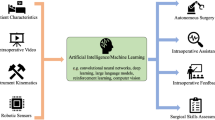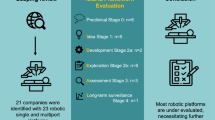Background
Laparoscopic Roux-en-Y gastric bypass (LRYGBP) is a technically demanding procedure, with a long learning curve.The aim of this study was threefold: to develop a task-based approach to training in LRYGBP, define a tool for objective technical skills assessments, and objectively determine the efficacy of this approach.
Methods
Videos of expert and novice surgeons performing LRYGBP on patients and anesthetised porcine models were analyzed to define an appropriate task for skills assessment. Subsequently, a jejunojejunostomy model was developed using cadaveric porcine small bowel, placed into a video-box trainer. 27 surgeons of varying experience levels in advanced laparoscopic procedures performed the task. Assessments of technical skill were by hand motion analysis and video-based scoring. A further 16 surgeons inexperienced in LRYGBP attended a taskbased hands-on training course and performed the jejuno-jejunostomy task at start and end of the course.
Results
The jejuno-jejunostomy model differentiated between surgeons of varying experience levels for time taken (P<0.001), economy of movement (P=0.001) and video scores (P<0.001). Surgeons attending the training course made significant improvements in time taken (P=0.002) and economy of movement (P=0.006), although not for generic video scores (P=0.243) by the end of course.
Conclusions
The structured, task-based approach for commencement of training in LRYGBP leads to objective improvements in the technical skills of inexperienced surgeons at the end of a short course. The next stage of the curriculum should be to achieve proficiency in the complete procedure on an anesthetised porcine model, prior to preceptorship on human cases.
Similar content being viewed by others
References
Yanovski SZ, Yanovski JA. Obesity. N Engl J Med 2002; 346: 591–602.
Buchwald H, Williams SE. Bariatric surgery worldwide 2003. Obes Surg 2004; 14: 1157–64.
Colquitt J, Clegg A, Sidhu M et al. Surgery for morbid obesity. Cochrane Database Syst Rev 2003; (2): CD003641.
Sjostrom L, Lindroos AK, Peltonen M et al. Lifestyle, diabetes, and cardiovascular risk factors 10 years after bariatric surgery. N Engl J Med 2004; 351: 2683–93.
Hall JC, Watts JM, O’Brien PE et al. Gastric surgery for morbid obesity. The Adelaide Study. Ann Surg 1990; 211: 419–27.
Olbers T, Fagevik-Olsen M, Maleckas A et al. Randomized clinical trial of laparoscopic Roux-en-Y gastric bypass versus laparoscopic vertical banded gastroplasty for obesity. Br J Surg 2005; 92: 557–62.
Sugerman HJ, Starkey JV, Birkenhauer R. A randomized prospective trial of gastric bypass versus vertical banded gastroplasty for morbid obesity and their effects on sweets versus non-sweets eaters. Ann Surg 1987; 205: 613–24.
Weber M, Muller MK, Bucher T et al. Laparoscopic gastric bypass is superior to laparoscopic gastric banding for treatment of morbid obesity. Ann Surg 2004; 240: 975–82.
Wittgrove AC, Clark GW, Tremblay LJ. Laparoscopic gastric bypass, Roux-en-Y: Preliminary Report of Five Cases. Obes Surg 1994; 4: 353–7.
Nguyen NT, Ho HS, Palmer LS et al. A comparison study of laparoscopic versus open gastric bypass for morbid obesity. J Am Coll Surg 2000; 191: 149–55.
Nguyen NT, Lee SL, Goldman C et al. Comparison of pulmonary function and postoperative pain after laparoscopic versus open gastric bypass: a randomized trial. J Am Coll Surg 2001; 192: 469–76.
Nguyen NT, Goldman C, Rosenquist CJ et al. Laparoscopic versus open gastric bypass: a randomized study of outcomes, quality of life, and costs. Ann Surg 2001; 234: 279–89.
Nguyen NT, Wolfe BM. Laparoscopic versus open gastric bypass. Semin Laparosc Surg 2002; 9: 86–93.
Ballantyne GH, Ewing D, Capella RF et al. The learning curve measured by operating times for laparoscopic and open gastric bypass: roles of surgeon’s experience, institutional experience, body mass index and fellowship training. Obes Surg 2005; 15: 172–82.
Gould JC, Garren MJ, Starling JR. Lessons learned from the first 100 cases in a new minimally invasive bariatric surgery program. Obes Surg 2004; 14: 618–25.
Nguyen NT, Rivers R, Wolfe BM. Factors associated with operative outcomes in laparoscopic gastric bypass. J Am Coll Surg 2003; 197: 548–55.
Oliak D, Ballantyne GH, Weber P et al. Laparoscopic Roux-en-Y gastric bypass: defining the learning curve. Surg Endosc 2003; 17: 405–8.
Schauer P, Ikramuddin S, Hamad G et al. The learning curve for laparoscopic Roux-en-Y gastric bypass is 100 cases. Surg Endosc 2003; 17: 212–5.
Shikora SA, Kim JJ, Tarnoff ME et al. Laparoscopic Roux-en-Y gastric bypass: results and learning curve of a high-volume academic program. Arch Surg 2005; 140: 362–7.
Higa KD, Boone KB, Ho T. Complications of the laparoscopic Roux-en-Y gastric bypass: 1,040 patients — what have we learned? Obes Surg 2000; 10: 509–13.
www.misfellowshipcouncil.org. Accesse Sept. 26, 2005 (Internet Communication).
Kothari SN, Boyd WC, Larson CA et al. Training of a minimally invasive bariatric surgeon: are laparoscopic fellowships the answer? Obes Surg 2005; 15: 323–9.
Integrating advanced laparoscopy into surgical residency training. Society of American Gastrointestinal Endoscopic Surgeons (SAGES). Surg Endosc 1998; 12: 374–6.
Guidelines for institutions granting bariatric privileges utilizing laparoscopic techniques. Society of American Gastrointestinal Endoscopic Surgeons (SAGES) and the SAGES Bariatric Task Force. Surg Endosc 2003; 17: 2037–40.
Hsu GP, Morton JM, Jin L et al. Laparoscopic Rouxen- Y gastric bypass: differences in outcome between attendings and assistants of different training backgrounds. Obes Surg 2005; 15: 1104–10.
Oliak D, Owens M, Schmidt HJ. Impact of fellowship training on the learning curve for laparoscopic gastric bypass. Obes Surg 2004; 14: 197–200.
Aggarwal R, Moorthy K, Darzi A. Laparoscopic skills training and assessment. Br J Surg 2004; 91: 1549–58.
Dosis A, Aggarwal R, Bello F et al. Synchronized video and motion analysis for the assessment of procedures in the operating theater. Arch Surg 2005; 140: 293–99.
Martin JA, Regehr G, Reznick R et al. Objective structured assessment of technical skill (OSATS) for surgical residents. Br J Surg 1997; 84: 273–8.
Moorthy K, Munz Y, Dosis A et al. Bimodal assessment of laparoscopic suturing skills: construct and concurrent validity. Surg Endosc 2004; 18: 1608–12.
Darzi A, Smith S, Taffinder N. Assessing operative skill. Needs to become more objective. BMJ 1999; 318: 887–8.
Vincent C, Moorthy K, Sarker SK et al. Systems approaches to surgical quality and safety: from concept to measurement. Ann Surg 2004; 239: 475–82.
Fried GM, Feldman LS, Vassiliou MC et al. Proving the value of simulation in laparoscopic surgery. Ann Surg 2004; 240: 518–25.
Roscoe SN. Incremental Transfer Effectiveness. Human Factors 1971; 13: 561–7.
Bridges M, Diamond DL. The financial impact of teaching surgical residents in the operating room. Am J Surg 1999; 177: 28–32.
Author information
Authors and Affiliations
Corresponding author
Rights and permissions
About this article
Cite this article
Aggarwal, R., Boza, C., Hance, J. et al. Skills Acquisition for Laparoscopic Gastric Bypass in the Training Laboratory — an Innovative Approach. OBES SURG 17, 19–27 (2007). https://doi.org/10.1007/s11695-007-9001-x
Received:
Accepted:
Published:
Issue Date:
DOI: https://doi.org/10.1007/s11695-007-9001-x




